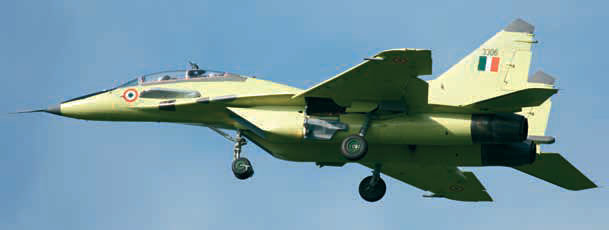|
 Tests of the first upgraded MiG-29UPGs are under way in Zhukovsky, Moscow Region, with the upgrades designed and performed by the MiG Corp. at the request by the Indian Defence Ministry. The first IAF MiG-29UPG serialled KBU3301 flew its maiden mission after the upgrade at the airfield of the LII Gromov Flight Research Institute in Zhukovsky on 4 February 2011. Two more upgraded aircraft including one twin-seater joined it in May when all three aircraft were demonstrated to Indian Air Force delegation headed by IAF’s Chief of the Air Staff Air Chief Marshal Pradeep Vasant Naik at LII airfield in Zhukovsky on 23 May 2011. Tests of the first upgraded MiG-29UPGs are under way in Zhukovsky, Moscow Region, with the upgrades designed and performed by the MiG Corp. at the request by the Indian Defence Ministry. The first IAF MiG-29UPG serialled KBU3301 flew its maiden mission after the upgrade at the airfield of the LII Gromov Flight Research Institute in Zhukovsky on 4 February 2011. Two more upgraded aircraft including one twin-seater joined it in May when all three aircraft were demonstrated to Indian Air Force delegation headed by IAF’s Chief of the Air Staff Air Chief Marshal Pradeep Vasant Naik at LII airfield in Zhukovsky on 23 May 2011.
The MiG Corp. has been implementing the MiG-29UPG programme under the contract signed on 7 March 2008 for integrated upgrade of the whole of the MIG-29 fleet of the Indian Air Force. In all, 62 aircraft, including several MiG-29UB two-seat combat trainers, are subject to upgrade. They are to be given more up-to-date avionics, with their weapons suite to be beefed up with advanced weapons. In addition, airframe and powerplant improvements will extend the fighters’ service life by far, and the aircraft will switch to on-condition maintenance. The fuel load will increase owing to a conformal spine fuel tank aft of the cockpit. At the same time, the fighters will get the mid-air refuelling capability.
Overall, the concept of upgrading the IAF MiG-29s corresponds to that of the MiG-29SMT that has been in service with the Russian Air Force since 2009 and mastered by Russian pilots. At the same time, there will be a high degree of avionics and weapons commonality with the MiG-29K/KUB carrierborne fighters that entered service with the Indian Navy on 19 February 2010. At the customer’s request, systems from various foreign manufacturers are integrated with the avionics suite of the upgraded MiG-29UPG (the so-called international avionics suite). Similar experience has been gained from the fulfilling of the Russian-Indian contracts for upgrade of the IAF’s MiG-21bis to MiG-21UPG Bison standard and for development and manufacture of the Su-30MKI and MiG-29K/KUB fighters. The experience has showed itself to good advantage.
The upgraded MiG-29UPG’s fire control system is wrapped around the advanced Phazotron-NIIR Zhuk-M2E slotted-array radar and OLS-UEM IRST with the laser, thermal-imager and TV capabilities from the NIIPP Precision Instrument Research Institute (now Precise Instrument System Scientific and Production Corporation, NPK SPP). The same radar and IRST fit the MiG-29K/KUB. The cockpit management system is based on colour multifunction liquid-crystal displays. The international segment of the avionics suite includes a helmet-mounted target designator from Thales, an inertial/satellite navigation system from Sagem, an Indian electronic intelligence system and an Israeli electronic countermeasures system (the same gear equips the MiG-29K/KUB).
In addition to the conformal fuel cell behind the cockpit and the mid-air refuelling boom on the portside, visual differences between the MiG-29UPG and the baseline MiG-29 include the underwing chaff/flare dispensers from Bharat Electronics and advanced antennae of the defence aids suite under wign and in the root of the right fin.
The basic weapons carried by the MIG-29UPG are the same as those carried by the MiG-29SMT and MiG-29K/KUB. Unlike the weapons suite of production MiG-29s, they also include the RVV-AE medium-range active radar homing air-to-air missiles and such precision-guided air-to-surface weapons, as the Kh-29T general-purpose TV-homing missile, Kh-31A active radar homing antiship missile, Kh-31P passive radar homing antiradation missile, KAB-500Kr TV-homing bombs, etc.
The MiG-29 has been in IAF’s inventory since 1987. Overall, 80 aircraft of the type had been delivered from the later 1980s to the mid-‘90s, including about 70 MiG-29 singleseaters (version B, or MiG-29B) and 10 MiG-29UB twinseaters. The delivery of the first batch of 44 fighters commenced in 1987, the second batch of 26 aircraft was delivered in 1989 and the third one (10 units) in 1994. Three IAF air squadrons operate the MiG-29 fighters – the 28th and 47th since December 1987 and the 223rd since November 1989. According to Indian warbirds.in website, at least 11 IAF MiG-29s, including a MiG-29UB, had been lost from 1994 to 2008 (at least four fatal accidents and seven incidents are known). According to Flight International, IAF had operated 69 fighters of the type by early 2011.
Under the contract, the first six IAF MIG-29s (four singleseaters and two twinseaters) shall be upgraded and tested in Russia, where they arrived from India in 2008. The remaining 56 aircraft will be upgraded in India at the production facilities of the IAF 11th Repair Base, using knockdown kits supplied from Russia. Mikhail Pogosyan, MiG Corp. Director General/Designer General and UAC President, said at the Aero India 2011 air show that the first MiG-29UPG would be returned to the customer this year following the completion of the tests.
|
